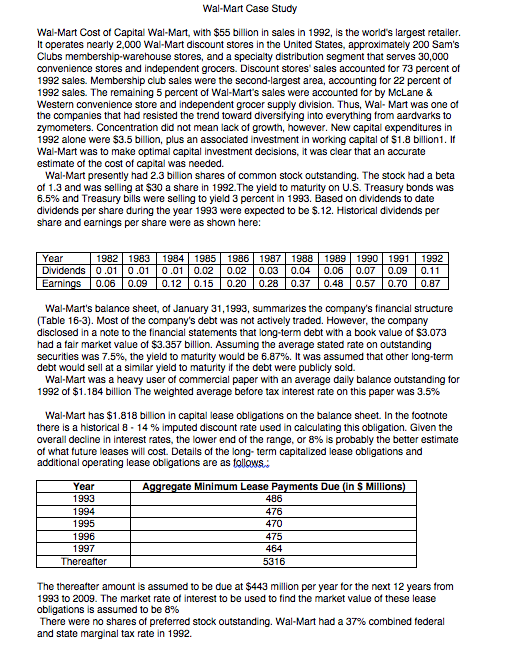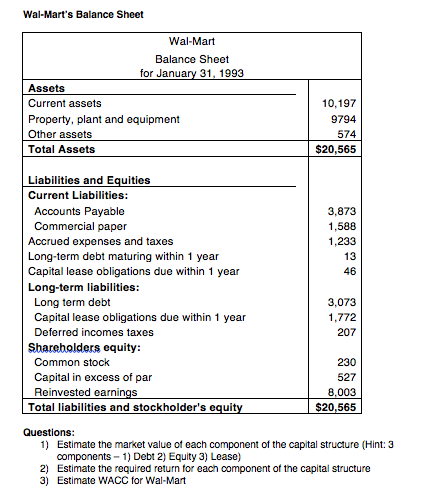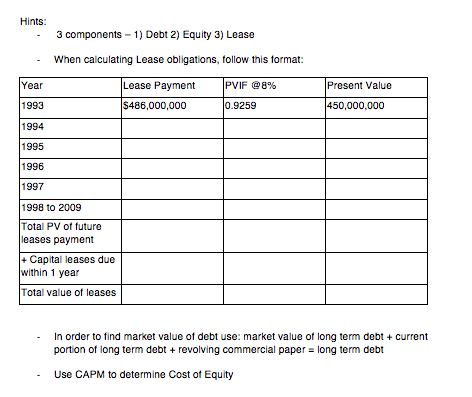Answered step by step
Verified Expert Solution
Question
1 Approved Answer
Please use the instructions provided under hints to get answer. Wal-Mart Case Study Wal-Mart Cost of Capital Wal-Mart, with $55 billion in sales in 1992,



Please use the instructions provided under "hints" to get answer.
Wal-Mart Case Study Wal-Mart Cost of Capital Wal-Mart, with $55 billion in sales in 1992, is the world's largest retailer It operates nearly 2,000 Wal-Mart discount stores in the United States, approximately 200 Sam's Clubs membership-warehouse stores, and a speciaity distribution segment that serves 30,000 convenience stores and independent grocers. Discount stores' sales accounted tor 73 percent of 1992 sales. Membership club sales were the second-largest area, accounting for 22 percent of 1992 sales. The remaining 5 percent of Wal-Mart's sales were accounted for by McLane & Western convenience store and independent grocer supply division. Thus, Wal- Mart was one of the companies that had resisted the trend toward diversifying into everything from aardvarks to zymometers. Concentration did not mean lack of growth, however. New capital expenditures in 1992 alone were $3.5 billion, plus an associated investment in working capital of $1.8 billion1. If Wal-Mart was to make optimal capital investment decisions, it was clear that an accurate estimate of the cost of capital was needed. Wal-Mart presently had 2.3 billion shares of common stock outstanding. The stock had a beta of 1.3 and was selling at $30 a share in 1992.The yield to maturity on U.S. Treasury bonds was 6.5% and Treasury bills were selling to yield 3 percent in 1993. Based on dividends to date dividends per share during the year 1993 were expected to be $.12. Historical dividends per share and earnings per share were as shown here: Year Dividends 0.01 0.01 0.01 0.02 0.02 0.030.04 0.060.07 0.09 0.11 Earnin 1982 | 1983 | 1984 | 1985 | 1986 | 1987| 1988 | 1989 | 1990| 1991 | 1992 0.06 0.09 0.12 0.15 0.20 0.28 0.37 0.48 0.57 0.70 0.87 Wal-Mart's balance sheet, of January 31,1993, summarizes the company's financial structure Table 16-3). Most of the company's debt was not actively traded. However, the company disclosed in a note to the financial statements that long-term debt with a book value of $3.073 had a fair market value of $3.357 billion. Assuming the average stated rate on outstanding securities was 7.5%, the yield to maturity would be 6.87%. It was assumed that other long-term debt would sell at a similar yield to maturity if the debt were publicly sold. Wal-Mart was a heavy user of commercial paper with an average daily balance outstanding tor 1992 of $1.184 billion The weighted average before tax interest rate on this paper was 3.5% Wal-Mart has $1.818 billion in capital lease obligations on the balance sheet. In the tootnote there is a historical 8-14 % imputed discount rate used in calculating this obligation. Given the overall decline in interest rates, the lower end of the range, or 8% is probably the better estimate of what future leases will cost Details of the long- term capitalized lease obligations and additional operating lease obligations are as tolloWS.. Year 1993 1994 1995 1996 1997 Thereafter te Minimum Lease Payments Due (in S Millions 486 476 470 475 464 5316 The thereafter amount is assumed to be due at $443 million per year for the next 12 years from 1993 to 2009. The market rate of interest to be used to find the market value of these lease obligations is assumed to be 8% There were no shares of preferred stock outstanding. Wal-Mart had a 37% combined federal and state marginal tax rate in 1992. Wal-Mart Case Study Wal-Mart Cost of Capital Wal-Mart, with $55 billion in sales in 1992, is the world's largest retailer It operates nearly 2,000 Wal-Mart discount stores in the United States, approximately 200 Sam's Clubs membership-warehouse stores, and a speciaity distribution segment that serves 30,000 convenience stores and independent grocers. Discount stores' sales accounted tor 73 percent of 1992 sales. Membership club sales were the second-largest area, accounting for 22 percent of 1992 sales. The remaining 5 percent of Wal-Mart's sales were accounted for by McLane & Western convenience store and independent grocer supply division. Thus, Wal- Mart was one of the companies that had resisted the trend toward diversifying into everything from aardvarks to zymometers. Concentration did not mean lack of growth, however. New capital expenditures in 1992 alone were $3.5 billion, plus an associated investment in working capital of $1.8 billion1. If Wal-Mart was to make optimal capital investment decisions, it was clear that an accurate estimate of the cost of capital was needed. Wal-Mart presently had 2.3 billion shares of common stock outstanding. The stock had a beta of 1.3 and was selling at $30 a share in 1992.The yield to maturity on U.S. Treasury bonds was 6.5% and Treasury bills were selling to yield 3 percent in 1993. Based on dividends to date dividends per share during the year 1993 were expected to be $.12. Historical dividends per share and earnings per share were as shown here: Year Dividends 0.01 0.01 0.01 0.02 0.02 0.030.04 0.060.07 0.09 0.11 Earnin 1982 | 1983 | 1984 | 1985 | 1986 | 1987| 1988 | 1989 | 1990| 1991 | 1992 0.06 0.09 0.12 0.15 0.20 0.28 0.37 0.48 0.57 0.70 0.87 Wal-Mart's balance sheet, of January 31,1993, summarizes the company's financial structure Table 16-3). Most of the company's debt was not actively traded. However, the company disclosed in a note to the financial statements that long-term debt with a book value of $3.073 had a fair market value of $3.357 billion. Assuming the average stated rate on outstanding securities was 7.5%, the yield to maturity would be 6.87%. It was assumed that other long-term debt would sell at a similar yield to maturity if the debt were publicly sold. Wal-Mart was a heavy user of commercial paper with an average daily balance outstanding tor 1992 of $1.184 billion The weighted average before tax interest rate on this paper was 3.5% Wal-Mart has $1.818 billion in capital lease obligations on the balance sheet. In the tootnote there is a historical 8-14 % imputed discount rate used in calculating this obligation. Given the overall decline in interest rates, the lower end of the range, or 8% is probably the better estimate of what future leases will cost Details of the long- term capitalized lease obligations and additional operating lease obligations are as tolloWS.. Year 1993 1994 1995 1996 1997 Thereafter te Minimum Lease Payments Due (in S Millions 486 476 470 475 464 5316 The thereafter amount is assumed to be due at $443 million per year for the next 12 years from 1993 to 2009. The market rate of interest to be used to find the market value of these lease obligations is assumed to be 8% There were no shares of preferred stock outstanding. Wal-Mart had a 37% combined federal and state marginal tax rate in 1992Step by Step Solution
There are 3 Steps involved in it
Step: 1

Get Instant Access to Expert-Tailored Solutions
See step-by-step solutions with expert insights and AI powered tools for academic success
Step: 2

Step: 3

Ace Your Homework with AI
Get the answers you need in no time with our AI-driven, step-by-step assistance
Get Started


